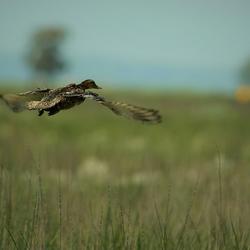Terrestrial Wildlife Diseases
Terrestrial Wildlife Diseases
Filter Total Items: 93
Expanding Distribution of Chronic Wasting Disease
Chronic wasting disease (CWD) has been detected in 36 US states and five Canadian provinces in free-ranging cervids and/or commercial captive cervid facilities. CWD has been detected in free-ranging cervids in 36 states and four provinces and in captive cervid facilities in 22 states and three provinces.
Avian Influenza Spread, Prevalence and Persistence
USGS researchers seek to understand the factors influencing the spread and persistence of avian influenza viruses on the landscape. This research also addresses how novel strains of highly pathogenic avian influenza are impacting a larger number and diversity of host species, including waterfowl, shorebirds, raptors and other birds.
Avian Influenza Host Movement Ecology
Understanding disease systems requires an understanding of the basic ecology of host species. USGS is involved in global efforts to explore the movements of bird species that are hosts of avian influenza as well as the potential impacts of changing landscapes on avian influenza.
Advancing Risk Modeling for Highly Pathogenic Avian Influenza
Southeast Asia has long been the epicenter of AIV emergence. However, as demonstrated by H5NX, these viruses can quickly reach global spread and have significant impacts on poultry production and human health. Researchers at the USGS Eastern Ecological Science Center have two ongoing efforts funded by the National Science Foundation to help improve our understanding of AIV emergence, spread, and...
Developing Tools to Evaluate Chronic Wasting Disease Transmission Risk
Chronic Wasting Disease (CWD) infects and kills ungulates (deer, elk, moose), and has been spreading across North America for the past 20 years. Some ungulate populations have declined because of CWD and there are no viable vaccines or treatments for this disease. Therefore, tools that assist wildlife managers in preventing and mitigating CWD can be powerful assets in protecting our nation’s big...
High Priority Species for Avian Influenza in Alaska
In early 2006, an Alaska Interagency Avian Influenza Working Group was formed to develop a ranking matrix for selecting priority species to be sampled within Alaska. Most wild bird species with populations that utilize areas of both Alaska and Asia were identified and considered in the ranking exercise. Based on scoring criteria, 28 target species were chosen for sampling. Alaska is a...
Avian Influenza Research
Since 2006, the USGS Alaska Science Center has been part of the State and Federal interagency team for the detection and response to highly pathogenic (HPAI) viruses in North America. Avian influenza or "bird flu" is a viral disease that primarily infects domestic poultry and wild birds. Avian influenza viruses are naturally occurring in wild birds such as ducks, geese, swans, and gulls. These...
Bird Migration and Influenza
The movement and transmission of avian influenza viruses in wild birds may differ by the migratory nature of each host species.
Deriving Spatial Waterfowl Inputs for Disease Risk Modeling
This project is an effort to create spatially and temporally explicit models for waterfowl distribution across the United States for use in avian influenza transmission risk modeling.
Avian Influenza Research at EESC
Emergence of avian influenza viruses with the potential to be highly pathogenic to poultry, wild birds, and humans cause serious concern for the global economic and public health sectors. Researchers at the USGS Eastern Ecological Science Center study multiple aspects of avian influenza viruses in wild birds as well as their implications for implications for commercial agriculture with a special...
Beak Deformities in Landbirds
Over the past 20 years, Alaskans have witnessed a startling increase of beak deformities among Black-capped Chickadees and other species of resident birds. This disease, called avian keratin disorder (AKD), is characterized by debilitating beak overgrowth and other abnormalities of keratinized tissues. Affected birds have difficulty feeding and preening and may suffer high rates of mortality.
Chronic Wasting Disease
Chronic wasting disease (CWD) affects cervids (elk, moose, mule deer, and white-tailed deer) throughout the U.S. CWD affects the nervous system in these animals and creates distinctive brain lesions. At this time, we have no treatment for CWD and it is fatal to the animals who contract it. CWD is caused by an infectious, irregular form of cellular prion protein. CWD can be directly and indirectly...












